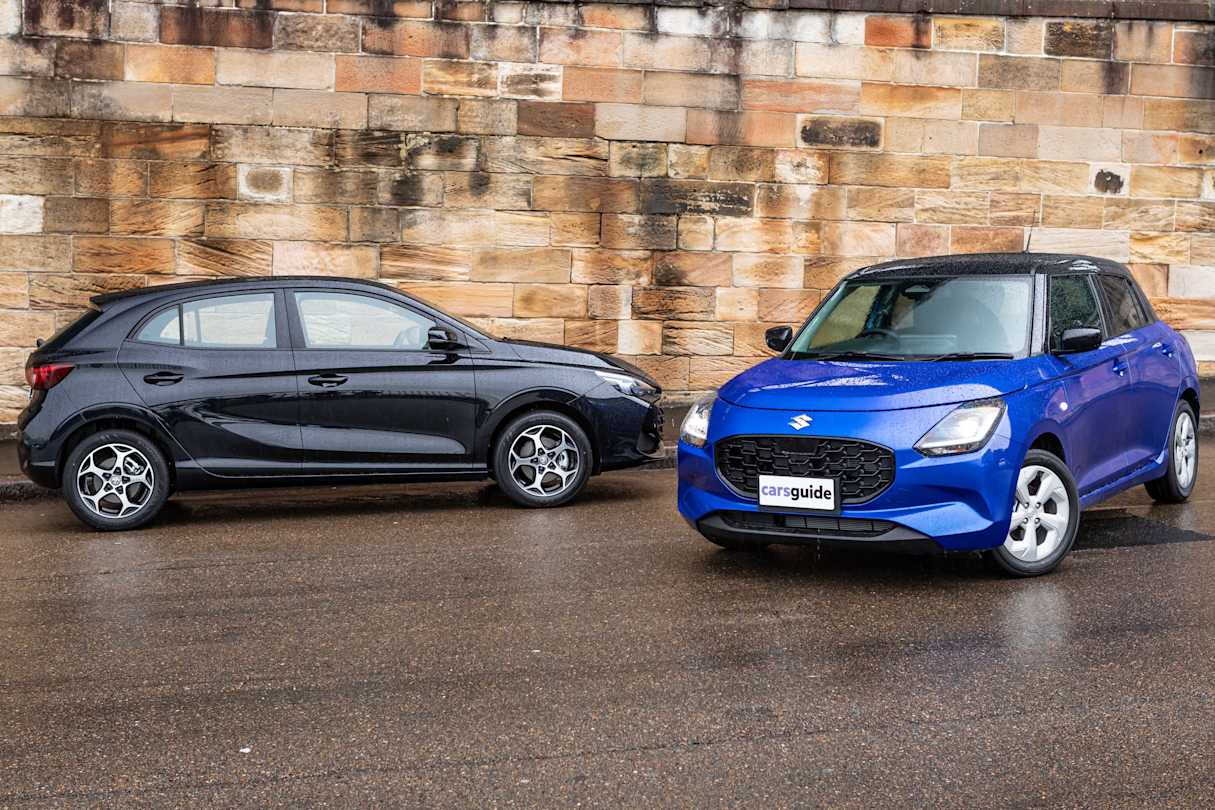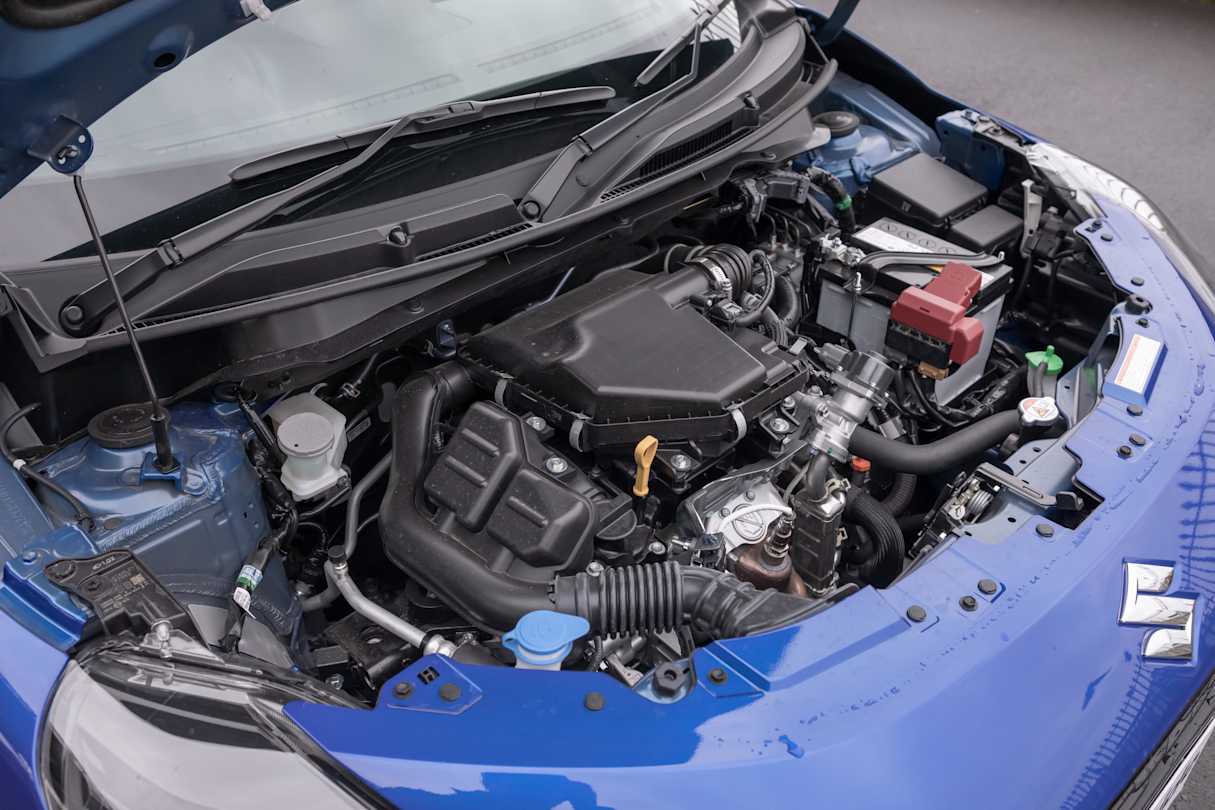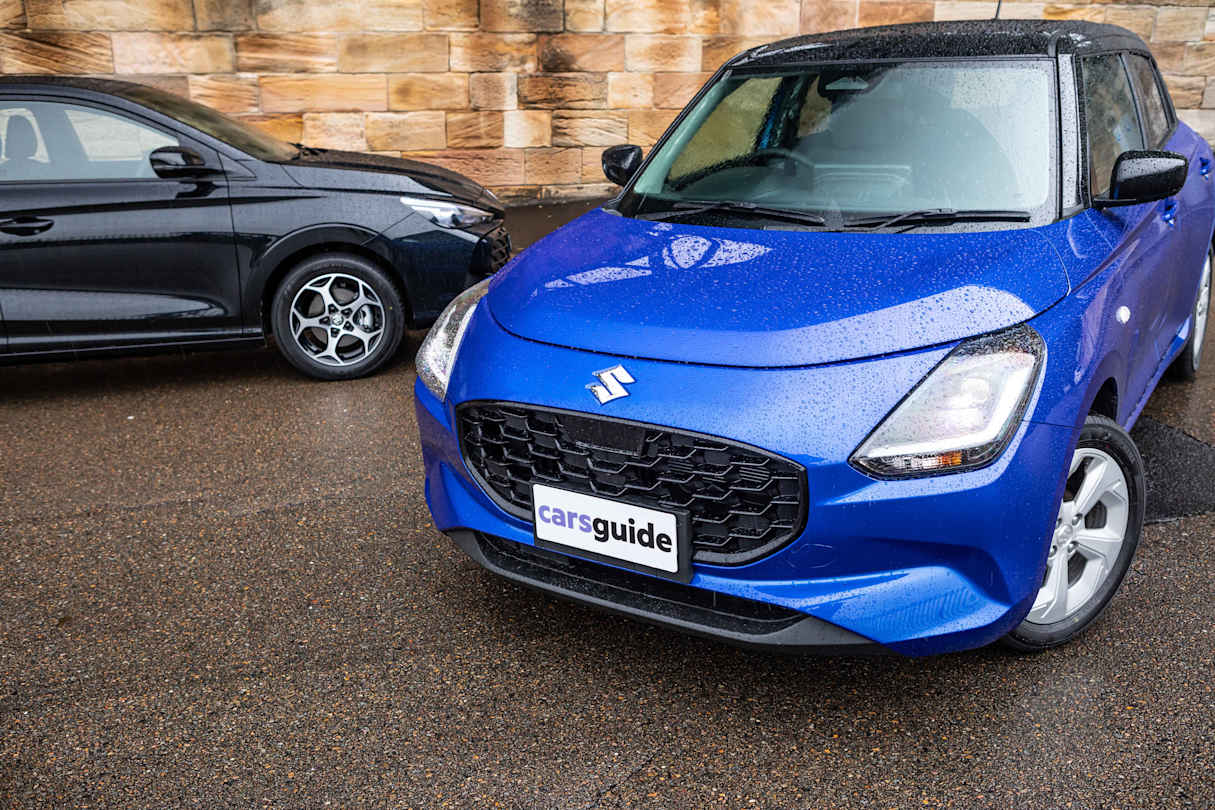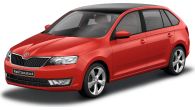You’ve set a new-car budget ceiling of $30,000. Your preference is for a small five-door hatch rather than the ubiquitous ‘compact SUV’ and with fuel price surges now a painfully regular part of life you like the idea of a hybrid.
Well, here are two well-credentialed, just-released contenders fitting that description ready to vie for your attention.
MG’s all-new MG3 replaces a model that’s dominated the light car segment in recent years and brings a new hybrid variant to the party. And Suzuki's Swift is an Aussie small car favourite with this recently launched sixth-generation version adding a mild-hybrid to the range.
We’ll get into how these city-sized newcomers shape up in terms of performance, economy, safety, practicality, value and more. So, stay with us to see which one has the best chance of filling that small car-sized space on your driveway.
Price and features – Do they represent good value for the price? What features do they come with?
In line with your budget these cars come in under $30K, before on-road costs… one of them, only just.
There are two MG3 Hybrid+ grades, the top-spec Essence and the entry-level Excite we’re testing here that just slips under the price cap at $29,990.
Sitting in the centre of three variants, the Suzuki Swift Hybrid Plus wears a 10 per cent lower price tag than the MG at $26,990 and there are some standard spec differences you should know about.

Both feature 16-inch alloy wheels, six-speaker audio, Apple CarPlay and Android Auto connectivity and fabric upholstery, however the MG’s central multimedia screen is bigger and its air-conditioning is auto climate control, where the Swift’s is manual.
But the Suzuki scores a few significant wins like LED headlights compared to the MG’s halogens, heated front seats, digital radio and a leather-trimmed steering wheel. Not to mention keyless entry, built-in nav and wireless Apple CarPlay.
The Swift also includes auto headlights with self-levelling and auto high-beam. Both boast heated exterior mirrors and the MG’s auto fold. But now we’re splitting hairs. Taking its lower cost-of-entry into account the Swift Hybrid Plus comes out in front in terms of price and features.
MG MG3 | Suzuki Swift | |
Price (MSRP) | $29,990 | $26,990 |
Multimedia screen | 10.25-inch | 9.0-inch |
LED headlights | ⛌ | ✓ |
Android Auto / Apple CarPlay | ✓ | ✓ (wireless Apple) |
Heated front seats | ⛌ | ✓ |
Upholstery | fabric | fabric |
Audio | six-speaker | six-speaker |
Nav | ⛌ | ✓ |
Digital radio | ⛌ | ✓ |
A/C | auto (single zone) | manual |
Keyless entry | ⛌ | ✓ |
Leather trimmed steering wheel | ⛌ | ✓ |
Auto rain-sensing wipers | ⛌ | ⛌ |
Alloy wheels | ✓ | ✓ |
Privacy glass | ⛌ | ✓ |
Steering column adjust | height | height & reach |
Wireless charging | ⛌ | ⛌ |
| Rating | 7.0 | 9.0 |
Design – Is there anything interesting about their designs?
In terms of exterior design the MG is a mix of hard character lines and sharp angles, for example in the headlights and tail-lights as well as vents front and rear.
Suzuki follows an evolutionary approach when it comes to the Swift’s design. Cover this latest version’s badges and thanks to its chunky proportions and upright stance, any half-decent car-spotter will still pick it.
A relatively high waistline gives the Swift a solid look while our test car’s two-tone premium ‘Frontier Blue Pearl’ paint (an $1145 option) with black turret enhances the signature ‘floating roof’ effect.
The MG3’s interior is clean and simple with the tone set by a twin-screen setup; a 10.25-inch multimedia display in the centre and a 7.0-inch instrument cluster in front of the driver.
But it’s dark, from the roof lining, to the dash, to the seats. And in this part of the market you can forget about soft-touch cabin materials, the plastics are hard save for some padding across the centre level of the dash.
By comparison the Swift’s interior is conventional with a relatively small media screen artificially enlarged by a broad gloss plastic frame. Analogue instruments, albeit with a multi-function digital screen in the centre (including a digital speedometer) look dated by comparison and the layered dash treatment appears fussy next to the MG’s layout.
Some grey and cream elements lighten the tone but, again, it’s a world of hard plastic surfaces inside the Suzuki.
Always a subjective call. We’re giving the design gong to the MG for its more contemporary approach, but I like the Swift, too, analogue instruments and all.
MG MG3 | Suzuki Swift | |||||||
| Rating | 8.0 | 7.0 | ||||||
Practicality – How practical is their space and tech inside?
At just over 4.1m long the MG3 is around 250mm longer than the Swift and not surprisingly its wheelbase is 120mm up on the Suzuki.
And there’s more than enough room up front in the MG and storage is good with bins in the doors and space for medium-sized bottles, as well as multiple cup/bottle holders in the centre console with movable dividers to structure the spaces as you see fit.
There’s a box between the front seats with a sliding tray inside it, alongside another partitioned oddments space and there’s a decent glove box.
For power and connectivity you’ve got USB-A and USB-C sockets with a 12-volt socket between them.
Important to note the MG’s steering column only adjusts for height which is a throwback to the 1990s, while the Swift’s adjusts for rake and reach, as you’d expect.
In terms of storage in the front of the Suzuki there are bins in the doors with room for bottles and cup/bottle holders in the centre console with an oddments tray in front of them (this becomes the wireless charging tray in the top-spec GLX).
No centre box/armrest between the front seats, just a low surround for the (manual) handbrake with a single cupholder at the back of it, more for backseaters than those in the front.
Again, there’s a generous glove box and this time around for connectivity there are two USB-A sockets (one for media) and a USB-C with a 12V next to them for power.
The rear of both of these city cars is surprisingly accommodating. Sitting behind the driver’s seat set to my 183cm position I have good foot, leg and headroom in each. Slightly less shoulder room in the Swift, which, after all, is 62mm narrower than the MG3.
Telling that neither car has map pockets on the front seat backs or a fold-down centre armrest with cupholders. But there are door bins in the MG3 with room for bottles while the Suzuki’s back doors have wells in them with just enough size for a mid-size bottle.
Big tick for the MG’s adjustable air vents for those in the back seat, with a small oddments tray and an additional USB-A outlet for power underneath it.
Boot space is surprisingly close with each of these minis able to hold the large and small cases from our three-piece luggage set. The MG3 offers 293 litres of volume with the Swift at 265L.
Worth noting the Suzuki’s rear seat splits and folds 60/40 for extra space and flexibility while the MG’s is a not as flexible single-piece folding backrest.
When it comes to a spare tyre, a repair/inflator kit is your only option for both of these cars, which is less than ideal.
Dimensions | MG MG3 | Suzuki Swift |
Length (mm) | 4113 | 3860 |
Width (mm) | 1797 | 1735 |
Height (mm) | 1502 | 1520 |
Wheelbase (mm) | 2570 | 2450 |
Boot volume (L) | 293/983 | 265/589 |
USB front | 1 x C / 1 x A | 1 x C / 2 x A |
USB rear | 1 x A | ⛌ |
Cupholders front | 2 | 2 |
Cupholders rear | ⛌ | 1 |
Bottleholders front | door bins | door bins |
Bottleholders rear | door bins | bottle tubes |
Adjustable rear A/C vents | ✓ | ⛌ |
12-volt socket | 1 x front | 1 x front |
Rear map pockets | ⛌ | ⛌ |
Spare tyre | repair kit | repair kit |
Glove box | medium | medium |
Front centre box/armrest | ✓ | ⛌ |
| Rating | 8.0 | 7.0 |
Under the bonnet – What are the key stats for their engines and transmissions?
Markedly different stories under the bonnets of these two.
The MG3 is a full petrol-electric hybrid with a 1.5-litre four-cylinder petrol engine working in concert with a separate electric motor on the front axle. Combined outputs are a healthy 155kW/425Nm.

While the Swift is mild hybrid powered by a 1.2-litre three-cylinder engine with an enhanced starter/generator/electric motor picking up some of the slack in terms of powering the stop-start system and adding 60Nm of torque for a little extra oomph when required. Output stats are 61kW/112Nm (plus 2.3kW/60Nm).
Both send drive to the front wheels, in the case of the MG through a three-speed ‘hybrid’ transmission managing combustion and electric drive simultaneously while the Suzuki uses a continuously variable auto transmission (CVT).
MG MG3 | Suzuki Swift | |
Engine | 1.5L 4cyl atmo petrol | 1.2L 3cyl atmo petrol |
Power (kW) | 75 @ 6000rpm | 61 @ 5700rpm |
Torque (Nm) | 128 @ 4500rpm | 112Nm @ 4500rpm |
Power combined (kW) | 155 @ 8000rpm | 'ISG' adds 2.3kW/60Nm |
Torque combined (Nm) | 425 | - |
Transmission | Three-speed ‘Hybrid’ auto | Continuously variable auto |
Drive | FWD | FWD |
| Rating | 8.0 | 7.0 |
Efficiency – What is their fuel consumption? What are their driving ranges?
MG claims the MG3 Hybrid consumes just 4.3L of fuel for every 100km travelled on the combined (urban/extra-urban) cycle, which is amazing for a car with its performance potential, but the featherweight Swift does even better at a miserly 4.0L/100km.
On test, over an extended mix of city, suburban and freeway running we saw the MG sip just 3.9L/100km, with the Swift on 3.8. To all intents and purposes a tie.
Worth noting both cars demand 95 RON premium unleaded fuel and based on our real-world results you can expect a range of around 1250km for the MG3 and 1025km for the Swift, the latter carrying a smaller fuel tank. Brilliant fuel efficiency.
L/100km | MG MG3 | Suzuki Swift |
Official combined cycle | 4.3 | 4.0 |
On test (bowser) | 3.9 | 3.8 |
On test (dash) | 4.3 | 4.3 |
CO2 (Combined cycle - g/km) | 100 | 90 |
Fuel tank (L) | 45 | 37 |
Fuel grade | 95 RON premium | 95 RON premium |
Range - Theoretical (Combined cycle - km) | 1046 | 925 |
Range - Real world (On test - km) | 1250 | 1027 |
Hybrid battery | 1.83kWh | 12-volt/10Ah |
| Rating | 9 | 9 |
Driving – What are they like to drive?
MG claims the MG3 Hybrid will accelerate from 0-100km/h in 8.0sec and it feels quick, especially in ‘Sport’ mode, rather than the ‘Eco’ and ‘Normal’ settings.
No doubt the MG is the quieter of the two and it’s important to point out the MG3 is able to run on pure electric power, while the Suzuki cannot.
Suspension is by struts at the front and torsion beam at the rear and the MG feels bumpier over typical pock-marked and patched urban surfaces. That may have something to do with the MG3’s 1298kg kerb weight and slightly wider and lower profile tyres - 195/55 vs 185/65.
The MG steers nicely through a squared-off steering wheel, a la the ‘quartic’ wheel found in the Austin Allegro and Rover SD1 from the 1970s. Road feel is good.
Disc brakes front and rear do the stopping on the MG with three levels of regenerative braking available. The most aggressive setting slows the car markedly but won’t bring it to a full stop, so no ‘single pedal’ driving.
By comparison, expect the Swift to reach 100km/h in around 12.5sec and first impressions are dominated by the characteristically coarse three-cylinder engine and exhaust sound.
Flick the Sport button on the gear shift and performance becomes more urgent but it can’t match the MG’s punch. That said, you can feel that extra 60Nm of pulling power when you want it.
But it’s the Suzuki’s supple ride and nimble handling that stand it apart. Despite its shorter wheelbase and substantially lighter weight the little Suzuki irons out bumps and thumps beautifully.
The steering is well-weighted, accurate and responsive with excellent road feel. Braking is by disc at the front and, yes, drums the size of a small Tupperware container at the rear.

But jokes aside, in a car this light a good drum brake will work perfectly well and it does here. No levels of regen braking. As soon as you’re off the throttle a small light on the dash lets you know you’re sending energy to the battery.
In terms of miscellaneous observations, the MG’s front seats aren’t as comfy as the Suzuki’s. In fact, all who drove the MG3 noticed the driver’s seat cushion is overly firm towards the rear, pushing into your tailbone.
The driver’s door armrests are hard in both cars and there’s some mild wind noise in the Swift at freeway speeds.
Both are super-easy to park but the Swift is that bit smaller with superior visibility, and neither car has a rotary dial for audio volume with wheel, dash buttons or screen sliders instead.
Overall both of these light hatches offer excellent dynamics and refinement for the money, but the Swift delivers a more relaxed and engaging drive.
MG MG3 | Suzuki Swift | |
0-100km/h (sec) | 8.0 | 12.5 |
Suspension | strut / torsion beam | strut / torsion beam |
Steering | rack & pinion | rack & pinion |
Wheels | 16-inch alloy | 16-inch alloy |
Tyres | 195/55 | 185/65 |
Spare | repair kit | repair kit |
Brakes | vented disc / disc | vented disc / drum |
Kerb weight (kg) | 1298 | 957 |
| Rating | 7.0 | 9.0 |
Warranty & Safety Rating
Safety – What safety equipment is fitted? What are their safety ratings?
Neither of these cars carries a current safety assessment from ANCAP but both do well in terms of active (crash-avoidance) technology.
Big ticket items like auto emergency braking (AEB), blind-spot monitoring, lane keeping assist and rear cross-traffic alert are present and accounted for, which is impressive in the under-$30K part of the market.
Both also feature adaptive cruise control, lane departure warning and rear parking sensors. But the MG adds lane change assist.

And if a crash is unavoidable it’s a tie on airbags at six each, with neither featuring the increasingly common front centre bag to minimise head clash injuries in a side impact.
Both have three top tethers and two ISOFIX anchors for child seats across the second row, although squeezing three seats into these small cars would be a feat worthy of Harry Houdini himself.
MG MG3 | Suzuki Swift | |
AEB | ✓ | ✓ |
Adaptive cruise control | ✓ | ✓ |
Lane departure warning | ✓ | ✓ |
Lane keeping assist | ✓ | ✓ |
Lane departure prevention | ✓ | ✓ |
Lane change assist | ✓ | ⛌ |
Blind-spot monitoring | ✓ | ✓ |
Traffic sign recognition | ✓ | ✓ |
Pedestrian and cyclist detection | ✓ | ✓ |
Rear cross-traffic alert | ✓ | ✓ |
Reversing camera | ✓ | ✓ |
Parking sensors | Rear | Rear |
Tyre pressure monitoring | ✓ | ✓ |
Driver monitoring | ✓ | ✓ |
ANCAP | Unrated | Not tested |
Front airbags | ✓ | ✓ |
Front side airbags | ✓ | ✓ |
Curtain airbags | ✓ | ✓ |
Child seat top tethers | Three | Three |
ISOFIX anchors | Two | Two |
| Rating | 8.0 | 8.0 |
Ownership – What warranty is offered? What are their service intervals? What are their running costs?
MG has just made an aggressive move in extending its warranty up to 10 years/250,000km which puts it ahead of Suzuki’s five-year/unlimited km cover, unless you’re a high-mileage driver.
Roadside assist is provided for five years if you have these cars serviced through their respective authorised networks and both offer fixed-price servicing.

Service intervals are 12 months or 10,000km for the MG3, or 12 months/15,000km for the Swift and costs are line ball… at an annual average of around $400 per workshop visit for each.
We’re giving it to the MG3 by a nose.
MG MG3 | Suzuki Swift | |
Warranty | 10-year/250,000km | Five-year/unlimited km |
Service interval | 12 months / 10,000km | 12 months / 15,000km |
Roadside Assist | Five years (conditional) | Five years (conditional) |
Fixed price servicing | Yes | Yes |
Annual average | $409 | $391 |
| Rating | 8.0 | 8.0 |
Verdict
This is close, with things like safety and these cars’ amazing fuel efficiency too close to call.
In terms of performance, practicality and the ownership package, the MG has the edge. But not by much, and when it comes to driving comfort and dynamics and critically, value for money, the Suzuki takes the lead.
Your particular priorities may drive a different decision, but in this head-to-head our nod goes to the Swift Hybrid Plus.
MG MG3 | Suzuki Swift | |
| Rating | 7.9 | 8.0 |





































































.jpg)


























